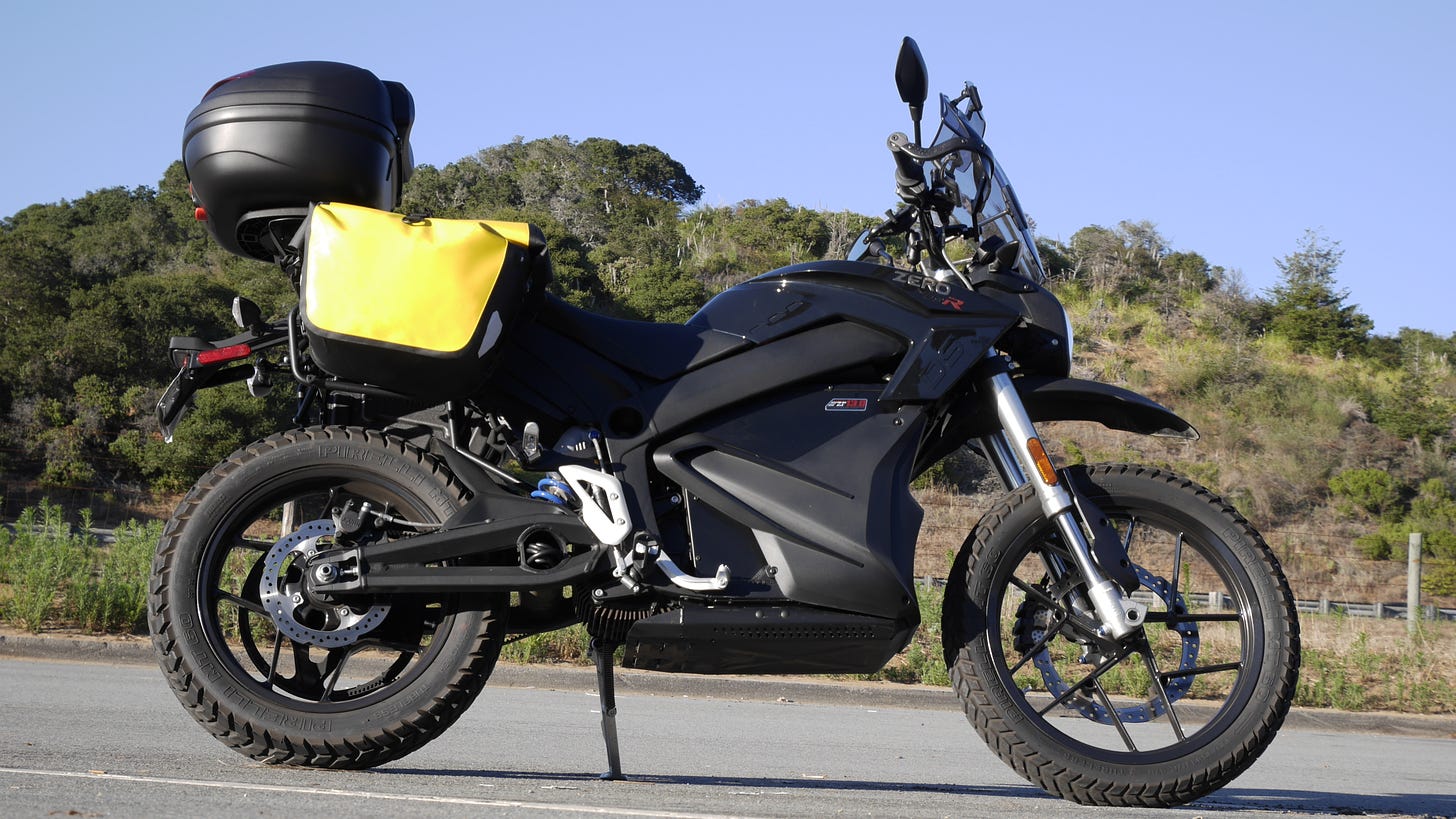[I take a break from the Wyman story now and again to write about other aspects of my trip. For those new to the Substack, the story begins here… I recommend viewing on a laptop or desktop or even a tablet to let the photos breathe a little more and help convey the vastness of the American West.]
At 55 mph, the 2016 Zero DSR electric motorcycle will go 88 miles on a full charge. In a perfect world, there’d be a charging station and Starbucks every 87 miles across the whole entire country so that I could drain the tank to nearly 0% and then refill it while sipping a vanilla latte and using free WiFi. But this isn’t a perfect world, and those estimates are based on a stock bike that doesn’t take into account the aerodynamics and weight of the windscreen, extra luggage, and chicken fried steaks that I am carrying. And I don’t always go 55 mph because highway speeds are high these days; I’m always keeping one eye on the road and one eye on the bike’s mirrors to see who’s approaching my six. If there’s a bunch of cars and trucks approaching quickly, I’ll raise my speed so that vehicles behind me don’t have to slow down too much from their cruising velocity. After they pass, I’ll bring my speed back down to maximize my range.
With all of this in mind, I assiduously follow the advice that someone from Zero Motorcycles gave me when I picked up the bike, "Don’t leave your current charging station until you know how far your next one is." Figuring out where the next one is located is accomplished in a number of ways. In areas where there is coverage, the ChargePoint app is good, providing a map and availability of nearby ChargePoint locations. In the more remote areas that I am traveling, the PlugShare app provides crowdsourced data on charging opportunities, everything from Tesla Superchargers (which the Zero cannot use, unfortunately) to parking garages that have 120 V outlets that were never really intended to charge a vehicle but are nonetheless available.
I have multiple ways to charge this Zero motorcycle:
Standard 120V Charger - this is the easiest but slowest way to charge; you simply plug the Zero into a standard wall outlet as if you were plugging in a computer or vacuum cleaner. Standard wall outlets provide 120 volts.
Optional ChargeTank - a charging socket and associated electronics that can connect to popular J1772 charge plugs available at non-Tesla car charging stations.
Accessory Charge Port - tucked up near the engine is an additional charging socket that can be connected to an external charger, like the Quic Charger I am carrying in the topcase. This heavy shoebox-sized metal box has cooling fins and two cords - one to plug into the accessory charge port, and the other to plug into a standard 120V outlet. It provides as much power as the standard 120V charger built into the motorcycle.
JuiceCord Adapter - a simple white box about the size of a carton of cigarettes with one cord that connects to the J1772 ChargeTank and another that connects to a 240V plug…the kind of plug that electric clothes dryers and RVs plug into.
The ChargeTank and the JuiceCord are the faster options, and can bring the Zero from nearly empty to 100% charge in about 3 hours. The standard 120V charger and Accessory Charge Port with Quic Charger are slower, requiring 7+ hours to charge the bike fully. The two can be combined to halve the charging time but care must be taken to use two outlets on different circuits or else the motorcycle is likely to draw too much power and trip the circuit breaker.
In the remotest areas, a pro tip by EV evangelist Ben Rich (the second person to cross the motorcycle via an electric motorcycle) the RV Parky app provides the locations of RV campsites including the availability of high current (50 amp) hookups.


With an abundance of EV car charging stations in California, riding from San Francisco to Reno, Nevada was a piece of cake. Now that I’m in Nevada, charging is going to be more challenging.
And this was 2016, which was not that long ago but a lifetime in EV years. It’s now possible to cross the country on an electric motorcycle in as little as a week, and along the major routes, charging is not nearly as challenging.








Interesting to learn about the different charging systems.